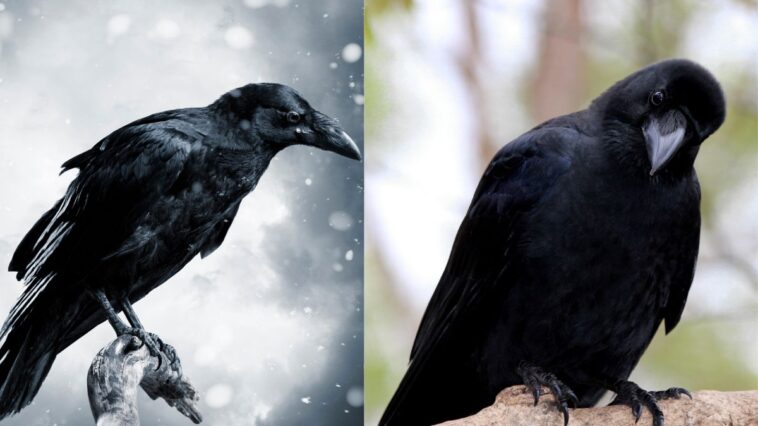In the realm of large black birds, ravens and crows stand out as remarkable and intriguing creatures. While they may share a common color palette, their physical differences set them apart in more ways than one. We can uncover the fascinating contrasts between these avian counterparts by delving into their distinct features and characteristics.
In exploring ravens and crows, we invite you to discover the physical disparities that distinguish these majestic birds. Each element contributes to its unique identity, from size and weight to beak shape, plumage, and tail structure.
By understanding these physical distinctions, we gain a deeper appreciation for the beauty and diversity within the world of these black-feathered marvels. So, join us as we unveil the physical disparities between ravens and crows, revealing a world where even the subtlest differences make a significant impact.
Ravens vs. Crows:Physical Differences
At first glance, ravens and crows may appear indistinguishable with their sleek black feathers, but a closer examination reveals many physical disparities that set them apart. Each characteristic adds to their distinct identities, from size and weight to beak shape and plumage.
Understanding these variations allows us to appreciate the fascinating diversity within the world of these black birds.
Here are the physical differences between ravens and crows:
Size: Ravens are generally larger than crows. They measure about 24-27 inches (61-69 cm), while crows are around 17 inches (43 cm) long.
Weight: Ravens are heavier than crows. Ravens typically weigh about 1.5-3.5 pounds (0.7-1.6 kg), while crows weigh about 3/4 – 1.5 pounds (0.3-0.7 kg).
Head Shape: Crows have triangular-shaped heads, whereas ravens have more rounded head shapes.
Beak Shape: Crows have pointed beaks, while ravens have thicker, more curved beaks.
Tail Shape: The shape of the tail is one of the most noticeable differences between ravens and crows. Crows have wedge-shaped tails, whereas ravens have more fan-like tails with curved feathers.
Plumage: Ravens have highly glossed plumage with iridescent colors, including greens, blues, and purples. Their feathers may appear shiny and can sometimes have an oily sheen. Crows also have glossy feathers, but their plumage is not as iridescent as that of ravens.
Sound: While both ravens and crows are known for their vocalizations, there are differences in their calls. Ravens have a deeper and more throaty croaking sound, whereas crows have a cawing sound that is generally more even and higher-pitched.
These physical differences can be useful in identifying and distinguishing between ravens and crows when observing them in the wild.
Ravens vs. Crows:Behavioral Differences
Ravens and crows, although related and share some behaviors, Ravens and crows also have distinct behavioral differences. Here are some notable behavioral differences between ravens and crows:
Social Behavior: Crows are highly social birds that often gather in large groups called “murders” or “flocks.” They engage in cooperative breeding, where parents and offspring from previous years help raise new offspring. In contrast, ravens tend to be less social and are often seen traveling in pairs or small family groups.
Communication: Ravens and crows are highly vocal and communicate with various calls and vocalizations. However, their specific vocalizations differ. Crows have a more even cawing sound, while ravens produce a deeper, throatier croaking sound. Ravens are known for their repertoire of varied calls and can mimic other sounds, including human speech, more often than crows.
Intelligence and Problem-Solving: Ravens are renowned for their high intelligence and problem-solving abilities. They are considered among the smartest bird species and exhibit complex cognitive skills. Ravens have been observed using tools in the wild and can plan for future tasks, showing advanced problem-solving abilities. Crows are also intelligent birds and exhibit problem-solving skills, but ravens are generally considered to be more advanced in this regard.
Flight Behavior: Ravens are known for soaring, utilizing updrafts and thermals to stay aloft. They have a more elegant and gliding flight style. Conversely, crows have a more straightforward flight pattern, flapping their wings more consistently.
Habitat Preference: While ravens and crows adapt to various habitats, they exhibit differences in their preferred environments. Crows are commonly found in open areas such as farmland, fields, suburbs, and urban areas. On the other hand, Ravens prefer wooded areas and forests, although they can also be found in open habitats like mountains and coastal cliffs.
Migration Patterns: In terms of migration, crows are considered partial migrants. Some crows migrate to different regions during specific seasons, while others may remain in their year-round territories. Ravens generally do not undertake long-distance migrations and tend to remain in their established ranges throughout the year.
These behavioral differences contribute to the unique characteristics and ecological roles of ravens and crows in their habitats.
Ravens vs. Crows:Habitat Differences
Ravens and crows have distinct habitat preferences, although they can overlap in certain areas. Here are the habitat differences between ravens and crows:
Ravens: Ravens are adaptable birds found in a wide range of habitats. They are commonly associated with forested areas, including coniferous and mixed forests. Ravens are well adapted to mountainous regions and can be found in rugged terrains like cliffs and rocky outcrops. They are also present in coastal habitats, including coastal cliffs and shorelines. Ravens are less commonly found in open grasslands and urban areas than crows.
Crows: Crows are highly adaptable and can thrive in various habitats. They are known for their ability to adapt to urban environments and can be seen in large numbers in cities. They are often found in more open environments such as agricultural fields, meadows, suburban areas, and even urban parks and gardens. Crows are well adapted to human-altered landscapes and can take advantage of food sources provided by human activities.
It’s worth noting that while ravens generally prefer wooded habitats and crows are more associated with open areas, there can be some overlap in their habitat preferences. For example, ravens and crows can be found in forested edges, where wooded areas meet open spaces. Also, ravens and crows may coexist in certain regions, such as urban environments with trees and open areas.
Overall, ravens tend to have a stronger affinity for forested and mountainous habitats. At the same time, crows are more adaptable and can be found in a wider range of environments, including both open and urban areas.
Cultural Significance of Ravens and Crows
Ravens and crows have significant cultural and symbolic meanings in various societies and belief systems worldwide. Here are some examples of their cultural significance:
Mythology and Folklore: Ravens and crows often feature prominently in myths, folklore, and legends across different cultures. In Norse mythology, ravens are associated with Odin and considered his companions and messengers. They are depicted as wise and observant beings. In Native American cultures, ravens and crows are revered and often seen as powerful and intelligent creatures with spiritual significance.
The symbolism of Wisdom and Knowledge: Ravens and crows are often associated with wisdom, intelligence, and foresight. They are seen as messengers between the human and spirit worlds, carrying secret knowledge and divine messages. Their high intelligence and problem-solving abilities have led to their symbolic representation as wise and insightful beings in many cultures.
Death and the Underworld: In some cultures, ravens, and crows are linked to death and the afterlife. Their dark coloration and scavenging behavior have led to their association with the deceased and the spirit realm. They are sometimes considered psychopomps, guiding souls to the afterlife or acting as omens of impending death.
Tricksters and Mischief: In folklore and mythology, the ravens and crows are often depicted as mischievous and cunning tricksters. They are known for their playful nature and cleverness, often outwitting other creatures and humans in stories. In some Native American and African traditions, crows are portrayed as tricksters with dualistic qualities, representing both positive and negative aspects of human nature.
Omens and Divination: The presence or behavior of ravens and crows is sometimes interpreted as omens or signs in different cultures. Their calls, flight patterns, or sudden appearances are believed to hold messages or warnings from the spiritual realm. In divination practices, the behavior or movements of ravens and crows may be observed to gain insights into future events or make important decisions.
Art, Literature, and Popular Culture: The intriguing nature and symbolism of ravens and crows have inspired numerous artistic representations, literary works, and popular culture references. They are often depicted in paintings, sculptures, and other forms of visual art. They have appeared in various literary works, including poetry, novels, and folklore collections. In popular culture, ravens and crows are often featured in films, music, and even sports team logos, evoking their mysterious and symbolic qualities.
These are just a few examples of the cultural significance of ravens and crows. These birds’ specific meanings and interpretations can vary across cultures and individual beliefs, adding to their rich and diverse symbolism.
Fun Facts About Ravens and Crows
Here are some fun facts about ravens and crows:
- Problem-Solving Abilities: Ravens and crows are highly intelligent birds known for their problem-solving skills. They have been observed using tools like sticks or rocks to obtain food or access hard-to-reach places.
- Vocal Capabilities: Ravens and crows are vocal birds with various calls and sounds. They can mimic other bird species, imitate human speech, and even create unique sounds. Some individual crows have been known to develop a “vocabulary” of specific words or sounds.
- Playfulness: Ravens and crows exhibit playful behavior, engaging in games and acrobatics. They can be seen sliding down snowbanks, performing aerial acrobatics, and playing with objects they find.
- Tool Use: Ravens are particularly adept at using and manipulating objects as tools. They have been observed using sticks to extract insects from crevices, dropping nuts onto hard surfaces to crack them open, and even manipulating water levels to access food.
- Social Intelligence: Both ravens and crows are highly social birds. They form complex social structures and have intricate communication systems. They can recognize and remember individual faces of humans and other animals, displaying remarkable social intelligence.
- Cultural Learning: Ravens and crows can learn from one another and pass on knowledge across generations. They can observe and imitate behaviors, allowing them to adapt to new situations and challenges.
- Feeding Habits: Both birds are opportunistic feeders and have a varied diet. While they are known to scavenge and consume carrion, they are also skilled hunters, catching small mammals, birds, insects, and fish.
- Lifespan: Ravens and crows have relatively long lifespans compared to many other bird species. In the wild, they can live up to 10-15 years; some individuals have been known to live even longer.
- Monogamy and Family Bonds: Ravens and crows form strong pair bonds and engage in long-term monogamous relationships. They also exhibit cooperative breeding behavior, with family members assisting in raising the young.
- Cultural Significance: Ravens and crows hold cultural significance in various societies and mythologies around the world, symbolizing traits such as wisdom, cunning, and mystery.
These fun facts highlight some fascinating aspects of ravens and crows, showcasing their intelligence, adaptability, and intriguing behaviors.
Conclusion
Ravens and crows may share a common coloration of black feathers, but their physical differences go far beyond appearances. Ravens, with their larger size, impressive wingspan, and heavier weight, stand out as the giants of the blackbird world. On the other hand, crows exhibited their charm with their slightly smaller stature and pointed beaks. These size, weight, and beak shape variations contribute to their distinct identities and make them easily recognizable in their natural habitats.
By understanding and appreciating the physical disparities between ravens and crows, we gain a deeper insight into the intricacies of the avian world. These remarkable creatures showcase the incredible diversity and adaptability found in nature. So, the next time you come across a large black bird soaring through the sky or perched on a branch, take a moment to observe its size, beak shape, and overall appearance.




